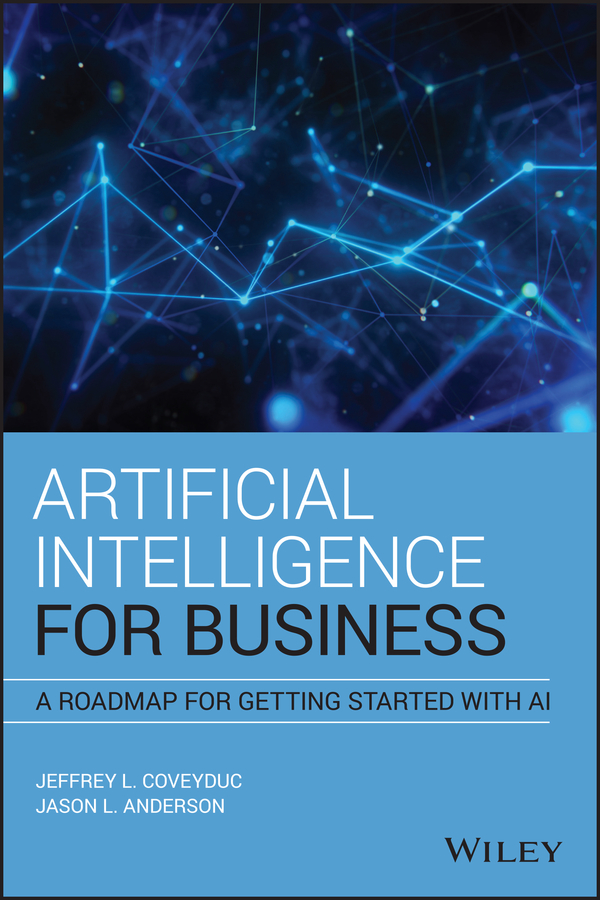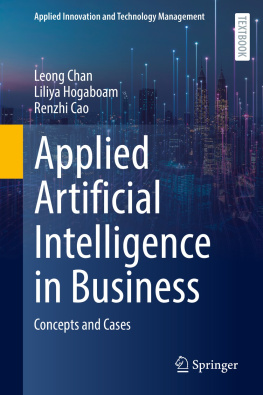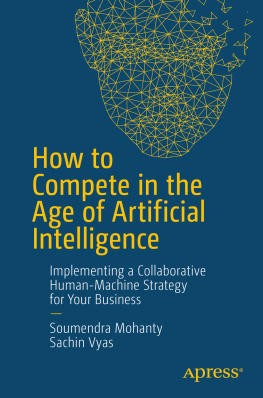
Table of Contents
List of Tables
- Chapter 2
- Chapter 5
List of Illustrations
- Chapter 1
- Chapter 2
- Chapter 3
- Chapter 4
- Chapter 5
- Chapter 6
- Chapter 7
Guide
Pages
Artificial Intelligence for Business
A Roadmap for Getting Started with AI
JEFFREY L. COVEYDUC
JASON L. ANDERSON

2020 Jeffrey L. Coveyduc and Jason L. Anderson
Published by John Wiley & Sons, Inc., Hoboken, New Jersey.
Published simultaneously in Canada.
The right of Jason L. Anderson and Jeffrey L. Coveyduc to be identified as the author(s) of the editorial material in this work has been asserted in accordance with law.
No part of this publication may be reproduced, stored in a retrieval system, or transmitted in any form or by any means, electronic, mechanical, photocopying, recording, scanning, or otherwise, except as permitted under Section 107 or 108 of the 1976 United States Copyright Act, without either the prior written permission of the Publisher, or authorization through payment of the appropriate per-copy fee to the Copyright Clearance Center, Inc., 222 Rosewood Drive, Danvers, MA 01923, (978) 750-8400, fax (978) 646-8600, or on the Web at www.copyright.com. Requests to the Publisher for permission should be addressed to the Permissions Department, John Wiley & Sons, Inc., 111 River Street, Hoboken, NJ 07030, (201) 748-6011, fax (201) 748-6008, or online at www.wiley.com/go/permissions.
Limit of Liability/Disclaimer of Warranty: While the publisher and author have used their best efforts in preparing this book, they make no representations or warranties with respect to the accuracy or completeness of the contents of this book and specifically disclaim any implied warranties of merchantability or fitness for a particular purpose. No warranty may be created or extended by sales representatives or written sales materials. The advice and strategies contained herein may not be suitable for your situation. You should consult with a professional where appropriate. Neither the publisher nor author shall be liable for any loss of profit or any other commercial damages, including but not limited to special, incidental, consequential, or other damages.
For general information on our other products and services or for technical support, please contact our Customer Care Department within the United States at (800) 762-2974, outside the United States at (317) 572-3993, or fax (317) 572-4002.
Wiley publishes in a variety of print and electronic formats and by print-on-demand. Some material included with standard print versions of this book may not be included in e-books or in print-on-demand. If this book refers to media such as a CD or DVD that is not included in the version you purchased, you may download this material at http://booksupport.wiley.com. For more information about Wiley products, visit www.wiley.com.
Library of Congress Cataloging-in-Publication Data
Names: Anderson, Jason L, author. | Coveyduc, Jeffrey L, author.
Title: Artificial intelligence for business : a roadmap for getting started with AI / Jason L Anderson, Jeffrey L Coveyduc.
Description: First edition. | Hoboken : Wiley, 2020. | Includes index.
Identifiers: LCCN 2020004359 (print) | LCCN 2020004360 (ebook) | ISBN 9781119651734 (hardback) | ISBN 9781119651413 (adobe pdf) | ISBN 9781119651802 (epub)
Subjects: LCSH: Artificial intelligenceEconomic aspects. | Business enterprisesTechnological innovations. | Artificial intelligenceData processing.
Classification: LCC HC79.I55 .A527 2020 (print) | LCC HC79.I55 (ebook) | DDC 006.3068dc23
LC record available at https://lccn.loc.gov/2020004359
LC ebook record available at https://lccn.loc.gov/2020004360
Cover Design: Wiley
Cover Image: Yuichiro Chino/Getty Images
Preface
Artificial intelligence (AI) has become so ingrained in our daily lives that most people knowingly leverage it every day. Whether interacting with an artificial entity such as the iPhone assistant Siri, or browsing through Netflix's recommendations, our functional adoption of machine learning is already well under way. Indirectly, however, AI is even more prevalent. Every credit card purchase made is run through fraud detection AI to help safeguard customers' money. Advanced logistical scheduling software is used to deliver tens of millions of packages daily, to locales around the world, with minimal disruption. In fact, the e-commerce giant Amazon alone claims to have shipped 5 billion packages with Prime in 2017 (see businesswire.com/news/home/20180102005390/en/). None of this would be possible on such a grand scale without the advances we have seen in AI systems and in machine learning technology over the last few decades.
Historically, these AI systems have been developed in-house by skilled teams of programmers, working around the clock at great expense to employers. This reality is now changing. Companies like IBM, Google, and Microsoft are making AI capabilities available on a pay-as-you-go basis, dramatically lowering the barrier to entry. For example, each of these companies provide speech-to-text and text-to-speech services to easily build voice interfaces for pennies per use. This is opening the door for smaller companies with less disposable capital to introduce AI initiatives that will produce substantial results. With the aforementioned backdrop of consumers interacting with AI on a daily basis, these consumers are becoming increasingly more comfortable and receptive to their brands adopting and incorporating more AI technology. The combination of all of these components makes it a smart bet for any modern company to start down the road toward AI adoption.
But how do these companies get started? This question is one we have seen time and again working with clients in the AI space. The drive and enthusiasm are there, but what organizational thought leaders are missing is the how to and overall direction. In our day jobs working with IBM Watson Client Engagement Centers and clients around the world, we repeatedly saw this pattern play out. Clients were eager to incorporate AI systems into their business models. They understood many of the benefits. They just needed a way in. While attending tech conferences and meetups, we find similar stories as well. Though the technological barriers are lower, with vendors providing accessible AI technology in the cloud, the challenge of coming up with the overall plan was still preventing many businesses from adopting AI. Having a good roadmap is essential to feeling comfortable with starting the journey. It is for this very reason that we wrote this book. Our goal is to empower you with the knowledge to successfully adopt AI technology into your organization. And you've already taken the first step by opening this book.
In addition to helping you adopt and understand emerging AI technology, this book will give you the tools to use AI to make a measurable impact in your business. Perhaps you will find some new cost-saving opportunities to unlock. Maybe AI will allow your business to uniquely position itself to enter new markets and take on competitors. Although AI has become more widespread and mainstream in its use in recent years, we are still seeing a tremendous amount of room for disruption in every field. That's the great thing about AIit can be applied in an interdisciplinary fashion to all domains, and the more it grows, the more its capabilities grow along with it. All that we ask of you, the reader, is to start with an open mind while we provide that missing roadmap to help you successfully navigate your way to driving value within your organization using AI.
Next page









